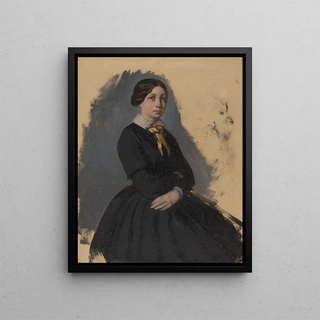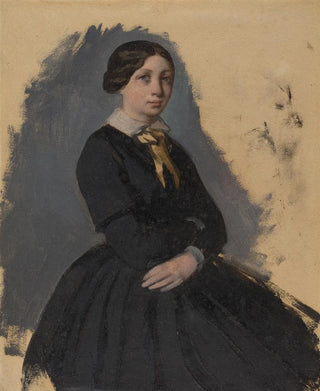Painting Young woman in black - Edgar Degas | Art print


View from behind

Frame (optional)
Art print Young woman in black - Edgar Degas – Captivating introduction
In the fascinating world of Impressionist art, the work "Young woman in black" by Edgar Degas stands out for its emotional depth and technical mastery. This painting, created at the end of the 19th century, evokes not only the beauty of a female figure but also the intimacy of a moment frozen in time. The young woman, whose face is partially turned, invites the viewer to ponder her thoughts and feelings. The soft light caressing her silhouette and the subdued atmosphere of the scene create a contemplative space, making the artwork all the more captivating.
Style and uniqueness of the work
Degas's style is characterized by a unique approach to movement and light, and "Young woman in black" is no exception. The palette of dark colors, dominated by black, emphasizes the silhouette of the young woman while highlighting the subtleties of her clothing. Delicate brushstrokes and the rich texture of the paint add a tactile dimension to the work, allowing the viewer to almost physically feel the presence of the model. Degas, a virtuoso, plays with shadows and lights to create an atmosphere that is both intimate and mysterious, where every detail matters. The woman's posture, both elegant and natural, demonstrates the artist's skill in capturing everyday beauty while infusing a certain melancholy into the scene.
The artist and his influence
Edgar Degas, an emblematic figure of the Impressionist movement, managed to transcend the conventions of his time. Born in Paris in 1834, he was influenced by the masters of the past while forging his own style. His interest in movement, which he explored through various subjects such as dance, theater, and daily life, opened new paths in modern art. "Young woman in black" fits into this quest to capture the essence of life through the prism of Impressionism. Degas's influence is still felt today, as his innovative approach has inspired generations of artists. His exploration of human forms and his ability to translate

Matte finish

View from behind

Frame (optional)
Art print Young woman in black - Edgar Degas – Captivating introduction
In the fascinating world of Impressionist art, the work "Young woman in black" by Edgar Degas stands out for its emotional depth and technical mastery. This painting, created at the end of the 19th century, evokes not only the beauty of a female figure but also the intimacy of a moment frozen in time. The young woman, whose face is partially turned, invites the viewer to ponder her thoughts and feelings. The soft light caressing her silhouette and the subdued atmosphere of the scene create a contemplative space, making the artwork all the more captivating.
Style and uniqueness of the work
Degas's style is characterized by a unique approach to movement and light, and "Young woman in black" is no exception. The palette of dark colors, dominated by black, emphasizes the silhouette of the young woman while highlighting the subtleties of her clothing. Delicate brushstrokes and the rich texture of the paint add a tactile dimension to the work, allowing the viewer to almost physically feel the presence of the model. Degas, a virtuoso, plays with shadows and lights to create an atmosphere that is both intimate and mysterious, where every detail matters. The woman's posture, both elegant and natural, demonstrates the artist's skill in capturing everyday beauty while infusing a certain melancholy into the scene.
The artist and his influence
Edgar Degas, an emblematic figure of the Impressionist movement, managed to transcend the conventions of his time. Born in Paris in 1834, he was influenced by the masters of the past while forging his own style. His interest in movement, which he explored through various subjects such as dance, theater, and daily life, opened new paths in modern art. "Young woman in black" fits into this quest to capture the essence of life through the prism of Impressionism. Degas's influence is still felt today, as his innovative approach has inspired generations of artists. His exploration of human forms and his ability to translate
12,34 €






